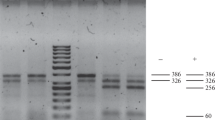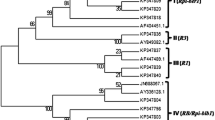Abstract
The causal agent of late blight, the oomycete Phytophthora infestans Mont de Bary, is characterized by a high degree of variability, as a result of which new races of the pathogen are able to overcome the resistance of long-term cultivated potato cultivars. Primitive cultivated potato species belong to the primary gene pool, the representatives of which easily cross with Solanum tuberosum L., and their use for breeding is promising. The objective of this study was to identify the genotypes of wild and primitive cultivated potato species from the VIR collection carrying the Rpi genes. For the first time, accessions of primitive cultivated and wild potato species (105 genotypes from the VIR collection) were analyzed for resistance to late blight and the presence of SCAR markers of the Rpi genes (RB/blb1, Rpi-blb2, R2-like, Rpi-vnt1.3). In the cultivated species S. stenotomum subsp. stenotomum, high (0.71) frequency of one of the two marker fragments of the RB/blb1 gene (Rpi-sto1), originally characterized in the wild North American species S. bulbocastanum, which belongs to the tertiary gene pool of potato species, was detected. In the species S. phureja and S. stenotomum subsp. goniocalyx, high frequency (0.71–0.88) of the Rpi-vnt1.3 gene marker, originally characterized in the wild South American species S. venturii, was found. For the first time, in primitive potato species, the fragment sequences, presumptive homologs of the Rpi-vnt1 and RB/blb1 genes, were characterized. In S. ajanhuiri, S. stenotomum, and S. phureja, three sequence variants homologous to Rpi-vnt1.3 were identified. The possible role of the detected polymorphism of the Rpi-vnt1.3 marker fragments in ensuring the resistance of primitive cultivated species to late blight is speculated.





Similar content being viewed by others
REFERENCES
Ristaino, J.B., Tracking historic migrations of the Irish potato famine pathogen, Phytophthora infestans, Microbes Infect., 2002, vol. 4, no. 13, pp. 1369—1377. https://doi.org/10.1016/s1286-4579(02)00010-2
Muratova (Fadina), O.A., Beketova, M.P., Kuznetsova, M.A., et al., South American species Solanum alandiae Card. and S. okadae Hawkes et Hjerting as potential sources of potato late blight resistance genes, Tr. Prikl. Bot., Genet. Sel., 2020, vol. 181, no. 1, pp. 73—83. https://doi.org/10.30901/2227-8834-2020-1-73-83
Kim, H.J., Lee, H.R., Jo, K.R., et al., Broad spectrum late blight resistance in potato differential set plants MaR8 and MaR9 is conferred by multiple stacked R genes, Theor. Appl. Genet., 2012, vol. 124, pp. 923—935. https://doi.org/10.1007/s00122-011-1757-7
Samen, F.M., Secor, G.A., and Gudmestad, N.C., Variability in virulence among asexual progenies of Phytophthora infestans, Phytopathology, 2003, vol. 93, no. 3, pp. 293—304. https://doi.org/10.1094/PHYTO.2003.93.3.293
Bradeen, J.M., Haynes, K.G., and Kole, C., Introduction to Potato: Genetics, Genomics and Breeding of Potatoes, Enfield, NH: Sci. Publ., 2011, pp. 1—19.
Haas, B., Kamoun, S., Zody, M., et al., Genome sequence and analysis of the Irish potato famine pathogen Phytophthora infestans, Nature, 2009, vol. 461, pp. 393—398. https://doi.org/10.1038/nature08358
Lee, Y., Cho, K.S., Seo, J.H., et al., Improved genome sequence and gene annotation resource for the potato Late Blight pathogen Phytophthora infestans, Mol. Plant—Microbe Interact., 2020, vol. 33, no. 8, pp. 1025—1028. https://doi.org/10.1094/MPMI-02-20-0023-A
Khavkin, E.E., Plant—pathogen molecular dialogue: evolution, mechanisms and agricultural implementation, Russ. J. Plant Physiol., 2021, vol. 68, pp. 197—211. https://doi.org/10.1134/S1021443721020072
Martin, M.D., Vieira, F.G., Ho, S.Y.W., et al., Genomic characterization of a South American Phytophthora hybrid mandates reassessment of the geographic origins of Phytophthora infestans, Mol. Biol. Evol., 2016, vol. 33, pp. 478—491. https://doi.org/10.1093/molbev/msv241
Spooner, D.M., Ghislain, M., Simon, R., et al., Systematics, diversity, genetics, and evolution of wild and cultivated potatoes, Bot. Rev., 2014, vol. 80, pp. 283—383. https://doi.org/10.1007/s12229-014-9146-y
Budin, K.Z., Genetic foci of Solanum species, Petota Dumort, resistant to Phytophthora infestans (Mont.) De Bary, Genet. Resour. Crop Evol., 2002, vol. 49, pp. 229—235. https://doi.org/10.1023/A:1015549214779
Potato Genome Sequencing Consortium, Genome sequence and analysis of the tuber crop potato, Nature, 2011, vol. 475, pp. 189—195. https://doi.org/10.1038/nature10158
Lozano, R., Ponce, O., Ramirez, M., et al., Genome-wide identification and mapping of NBS-encoding resistance genes in Solanum tuberosum group phureja, PLoS One, 2012, vol. 7, no. 4. https://doi.org/10.1371/journal.pone.0034775
Sliwka, J., Jakuczun, H., Lebecka, R., et al., The novel, major locus Rpi-phu1 for late blight resistance maps to potato chromosome IX and is not correlated with long vegetation period, Theor. Appl. Genet., 2006, vol. 113, no. 4, pp. 685—695. https://doi.org/10.1007/s00122-006-0336-9
Śliwka, J., Jakuczun, H., Kamiński, P., et al., Marker-assisted selection of diploid and tetraploid potatoes carrying Rpi-phu1, a major gene for resistance to Phytophthora infestans, J. Appl. Genet., 2010, vol. 51, pp. 133—140. https://doi.org/10.1007/BF03195721
Foster, S., Park, T.H., Pel, M., et al., Rpi-vnt1.1, a Tm-22 homolog from Solanum venturii, confers resistance to potato late blight, Mol. Plant—Microbe Interact., 2009, vol. 22, pp. 589—600. 10.1094/MPMI-22-5-0589
Pel, M.A., Foster, S.J., Park, T.H., et al., Mapping and cloning of late blight resistance genes from Solanum venturii using an interspecific candidate gene approach, Mol. Plant—Microbe Interact., 2009, vol. 22, pp. 601—615. https://doi.org/10.1094/MPMI-22-5-0601
Song, J., Bradeen, J.M., Naess, S.K., et al., Gene RB cloned from Solanum bulbocastanum confers broad spectrum resistance to potato late blight, Proc. Natl. Acad. Sci. U.S.A., 2003, vol. 100, no. 16, pp. 9128—9133. https://doi.org/10.1073/pnas.1533501100
van der Vossen, E.A., Gros, J., Sikkema, A., et al., The Rpi-blb2 gene from Solanum bulbocastanum is an Mi-1 gene homolog conferring broad-spectrum late blight resistance in potato, Plant J., 2005, vol. 44, pp. 208—222. https://doi.org/10.1111/j.1365-313X.2005.02527.x
Orbegozo, J., Roman, M.L., Rivera, C., et al., Rpi-blb2 gene from Solanum bulbocastanum confers extreme resistance to late blight disease in potato, Plant Cell Tiss. Organ Cult., 2016, vol. 125, pp. 269—281 https://doi.org/10.1007/s11240-016-0947-z
Zhu, S., Li Y., Vossen, J.H., et al., Functional stacking of three resistance genes against Phytophthora infestans in potato, Transgenic Res., 2012, vol. 21, no. 1, pp. 89—99. https://doi.org/10.1007/s11248-011-9510-1
Aguilera-Galvez, C., Champouret, N., Rietman, H., et al., Two different R gene loci co-evolved with Avr2 of Phytophthora infestans and confer distinct resistance specificities in potato, Stud. Mycol., 2018, vol. 89, pp. 105—115. https://doi.org/10.1016/j.simyco.2018.01.002
Rogozina, E.V. and Gurina, A.A., Composition of the collection of primitive cultivated species within the Solanum L. section Petota Dumort. and current trends in their studies, Tr. Prikl. Bot., Genet. Sel., 2020, vol. 181, no. 3, pp. 190—202. https://doi.org/10.30901/2227-8834-2020-3-190-202
Gabriel, J., Plata, G., Cadima, X., and Franco, J., Solanum phureja Juz et Buk.: valuable source of genetic resistance to potato Late Blight (Phytophthora infestans (Mont.) de Bary), Rev. Latinoam. Papa, 2013, vol. 17, pp. 131—142
Blossei, J., Uptmoor, R., Thieme, R., et al., Insights into the genetic basis of the pre-breeding potato clones developed at the Julius Kühn Institute for high and durable late blight resistance, Plant Genet. Resour.: Charact. Util., 2021, vol. 1, no. 4. https://doi.org/10.1017/S1479262121000447
Jupe, F., Pritchard, L., Etherington, G.J., et al., Identification and localisation of the NB-LRR gene family within the potato genome, BMC Genomics, 2012, vol. 13, no. 75. https://doi.org/10.1186/1471-2164-13-75
Hawkes, J.G., The Potato: Evolution, Biodiversity and Genetic Resources, London: Belhaven Press, 1990.
Mironenko, N.V., Rogozina, E.V., Gurina, A.A., et al., Wild relatives and interspecific hybrids of potato as source materials in breeding for resistance to golden nematode, Tr. Prikl. Bot., Genet. Sel., 2020, vol. 181, no. 4, pp. 173—184. https://doi.org/10.30901/2227-8834-2020-4-173-184
Brylińska, M. and Śliwka, J., Laboratory assessment of potato resistance to Phytophthora infestans, Plant Breed. Seed Sci., 2017, vol. 76, pp. 17—23. https://doi.org/10.1515/plass-2017-00016
Khyutti, A.V., Rybakov, D.A., Gavrilenko, T.A., and Afanasenko, O.S., Resistance to late blight causal agent and golden potato nematode of modern cultivars of seed potatoes and their phytosanitary status in different agroclimatic zones of the European part of Russia, Vavilovskii Zh. Genet. Sel., 2020, vol. 24, no. 4, pp. 363—375. https://doi.org/10.18699/VJ20.629
Vleeshouwers, V.G., Van Dooijeweert, W., Keizer, L.C., et al., A laboratory assay for Phytophthora infestans resistance in various Solanum species reflects the field situation, Eur. J. Plant Pathol., 1999, vol.105, pp. 241—250. https://doi.org/10.1023/A:1008710700363
Gavrilenko, T., Antonova, O., Shuvalova, A., et al., Genetic diversity and origin of cultivated potatoes based on plastid microsatellite polymorphism, Genet. Resour. Crop Evol., 2013, vol. 60, no. 7, pp. 1997—2015. https://doi.org/10.1007/s10722013-9968-1
Haesaert, G., Vossen, J.H., Custers, R., et al., Transformation of the potato variety Desiree with single or multiple resistance genes increases resistance to late blight under field conditions, Crop Prot., 2015, vol. 77, pp. 163—175. https://doi.org/10.1016/J.CROPRO.2015.07.018
Wang, M., Allefs, S., van den Berg, R.G., et al., Allele mining in Solanum: conserved homologues of Rpi-blb1 are identified in Solanum stoloniferum, Theor. Appl. Genet., 2008, vol. 116, no. 7, pp. 933—943. https://doi.org/10.1007/s00122-008-0725-3
Lenman, M., Ali, A., Mühlenbock, P., et al., Effector-driven marker development and cloning of resistance genes against Phytophthora infestans in potato breeding clone SW93-1015, Theor. Appl. Genet., 2016, vol. 129, no. 1, pp. 105—115. https://doi.org/10.1007/s00122-015-2613-y
Alpatieva, N.V., Antonova, O.Yu., and Radchenko, E.E., et al., PTsR-diagnostika vrednykh organizmov guara (metodicheskie ukazaniya) (PCR Diagnostics for Harmful Organisms of Guar (Guidelines)), St. Petersburg: Vseross. Inst. Rastenievod., 2019. https://doi.org/10.30901/978-5-907145-44-3
Tamura, K., Stecher, G., Kumar, S., MEGA11: Molecular Evolutionary Genetics Analysis version 11, Mol. Biol. Evol., 2021, vol. 38, no. 7, pp. 3022—3027. https://doi.org/10.1093/molbev/msab120
Huaman, Z. and Ross, R., Updated listing of potato species names, abbreviations and taxonomic status, Am. Potato J., 1985, vol. 62, no. 11, pp. 629—641. https://doi.org/10.1007/BF02854438
Pel, M.A., Mapping, isolation and characterization of genes responsible for late blight resistance in potato, PhD Thesis Wageningen University, The Netherlands, 2010.
Mason, J.M. and Arndt, K.M., Coiled coil domains: stability, specificity, and biological implications, ChemBioChem, 2004, vol.5, pp. 170—176. https://doi.org/10.1002/cbic.200300781
Plich, J., Tatarowska, B., Lebecka, R., et al., R2-like gene contributes to resistance to Phytophthora infestans in Polish potato cultivar Bzura, Am. J. Potato Res., 2015, vol. 92, pp. 350—358. https://doi.org/10.1007/s12230-015-9437-9
Veilleux, R.E., Genetic stocks used for potato genome sequencing, in The Potato Genome Compendium of Plant Genomes, Cham: Springer-Verlag, 2017. https://doi.org/10.1007/978-3-319-66135-3_4
Tiwari, J.K., Devi, S., Sharma, S., et al., Allele mining in Solanum germplasm: cloning and characterization of RB-homologous gene fragments from late blight resistant wild potato species, Plant Mol. Biol. Rep., 2015, vol. 33, no. 5, pp. 1584—1598. https://doi.org/10.1007/s11105-015-0859-9
ACKNOWLEDGMENTS
Sequencing of the Rpi gene fragments was carried out using the equipment of the Genomic Technologies, Proteomics, and Cell Biology Resource Center of the All-Russian Research Institute for Agricultural Microbiology, Pushkin, St. Petersburg.
Funding
This study was supported by the Russian Science Foundation, grant no. 22-26-00111 “Potato Late Blight Resistance Genes in the Context of the Evolution of Cultivated and Wild Tuber-Bearing Species of Solanum L.”
Author information
Authors and Affiliations
Corresponding author
Ethics declarations
Statement on the welfare of animals. This article does not contain any research using animals as a subject.
Statement of compliance with standards of research involving humans as subjects. This article does not contain any research involving humans as a subject.
Conflict of interest. The authors declare that they have no conflicts of interest.
Additional information
Translated by N. Maleeva
Supplementary Information
Rights and permissions
About this article
Cite this article
Gurina, A.A., Alpatieva, N.V., Chalaya, N.A. et al. Homologs of Late Blight Resistance Genes in Representatives of Tuber-Bearing Species of the Genus Solanum L.. Russ J Genet 58, 1473–1484 (2022). https://doi.org/10.1134/S1022795422120043
Received:
Revised:
Accepted:
Published:
Issue Date:
DOI: https://doi.org/10.1134/S1022795422120043




